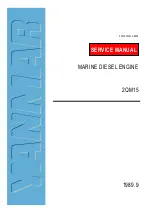
17B
-
35
PETROL INJECTION
Oxygen sensor fault finding
L90, and K7J, and 710 – L90, and K7M, and 710
17B
FOR VEHICLES FITTED WITH O.B.D:
The purpose of oxygen sensor fault finding is to detect
a fault which would cause the On Board Diagnostic limit
to be exceeded by hydrocarbon pollutant emissions. It
is performed by measuring and comparing oxygen sen-
sor vibration periods.
There are two types of possible faults on the oxygen
sensors:
- mechanical damage to an electrical component (brea-
kage, cut in wire) which leads to an electrical fault,
- chemical damage to the component which causes the
response time of the sensor to slow down, thus in-
creasing its switching period.
When the required test conditions are met, the average
of the sensor periods read is taken, subtracting the ef-
fects of interference, then compared with a period of
the On Board Diagnostic limit.
I -TEST CONDITIONS
Fault finding of the oxygen sensor can only take place
after the engine has been running for a while and under
specific operating conditions, detailed in the table be-
low, and if all the conditions prior to the ignition being
switched on are met and maintained:
- no electrical faults detected,
- programming and cylinder recognition done,
- no oxygen sensor fault finding performed since the
ignition was switched on,
- water temperatureover 75˚C.
II - FAULT DETECTION
Fault finding is performed while the vehicle is being driven in one gear, travelling at a steady speed and for
the minimum period of time specified in the following table:
For this test, the computer inhibits petrol vapour canis-
ter bleeding.
The computer gives the «
sensors fault finding
included » signal.
If after the test, the diagnostic tool has found a lambda
sensor fault, (see Workshop Repair Manual 390 Fault
finding, 17B, Petrol injection, Summary of faults).
III - CONFIRMATION OF REPAIR
- ET102: «
Sensor fault finding included
»:
« ACTIVE »,
- ET106: « Sensor fault finding done »: « ACTIVE »,
- no fault detected and the On Board Diagnostic war-
ning light is out.
Engine
Speed, mph
(kph)
Engine speed
(rpm)
Manifold pres-
sure (mbar)
Stabilisation
time (seconds)
Time before
autorisation
(minutes)
K7M
63 to 130
1,856 to 3,808
380 to 850
8
14
K7J
63 to 130
1,856 to 3,808
380 to 850
8
14
Engine
Gearbox ratio
Speed, mph (kph)
Maximum period (s)
K7J
5
70
40
K7M
5
70
40
WARNING
At the end of each test, it is essential that the igni-
tion is not switched off before the result is read on
the diagnostic tool. Switching off the ignition will
lead to the results being misinterpreted.
















































